Delaware boasts not only a rich history but also a diverse and stunning natural landscape. One of the most compelling aspects of this state’s natural beauty is its native trees. Journey through the heart of the Diamond State’s wilderness to explore the fifteen most iconic trees native to Delaware.
From the elegant American holly to the towering tulip poplar, each tree tells a story of resilience and adaptation in this unique corner of the United States. Delve into the vibrant world of Delaware’s native trees, celebrating their significance in both the state’s ecology and cultural heritage.
1. American Beech (Fagus grandifolia)
The American beech is a native deciduous tree found throughout Delaware’s woodlands. This tree, known for its smooth bark, glossy leaves, and brilliant fall foliage, holds a special place in Delaware. The American beech typically reaches heights of 50 to 80 feet, boasting a stately appearance.
Its smooth, pale gray bark stands out in Delaware’s woodlands, especially in the winter months. Furthermore, the tree’s leaves are another distinguishing feature, with their glossy dark green upper surface and lighter green underside. They are also oval-shaped with serrated edges and a pointed tip.
During the autumn season, the American beech trees in Delaware put on a breathtaking display of colors. Their leaves transition to brilliant shades of golden-yellow and copper-orange, transforming the state’s forests into a vibrant and picturesque landscape. The American beech thrives in a variety of forested habitats across Delaware, including mixed hardwood forests and beech-maple stands.
Delaware’s American beech trees play a crucial role in supporting local wildlife. Beechnuts are a vital food source for many creatures in the state, including squirrels, deer, birds, and small mammals. Additionally, the tree’s dense canopy provides shelter and nesting sites for various bird species. Native American tribes and early European settlers in Delaware used different parts of the tree for sustenance, medicine, and crafting.
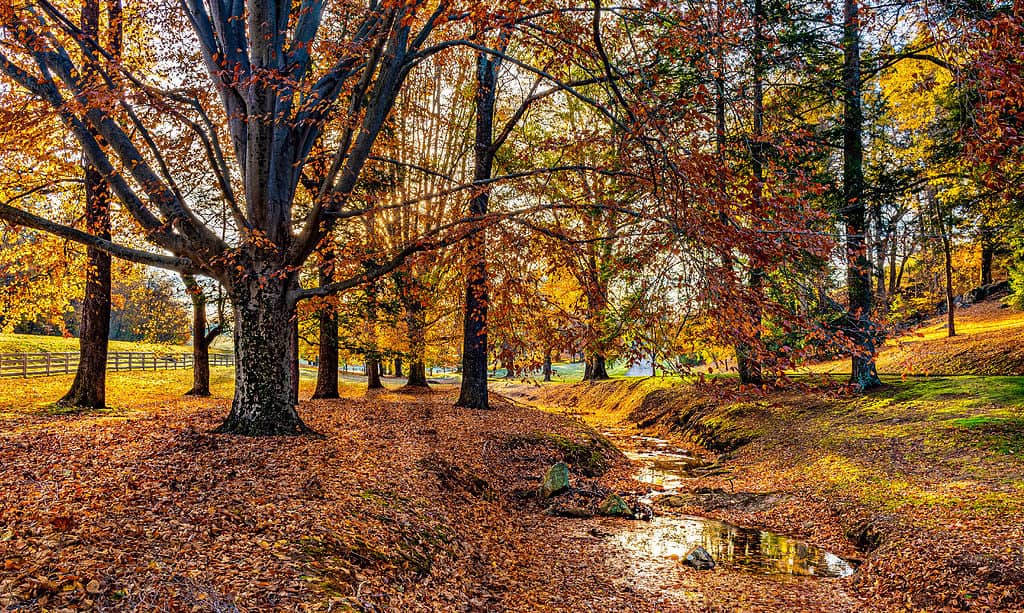
American beech trees often form a mutually beneficial relationship with a type of fungus called mycorrhizae, which helps the tree absorb nutrients from the soil.
©Gerry Bishop/Shutterstock.com
2. American Holly (Ilex opaca)
The American holly is a native evergreen tree found in various parts of the eastern United States, including Delaware. This iconic tree species holds cultural, ecological, and aesthetic significance in the region. American holly trees produce glossy, dark green leaves with serrated edges. These leaves remain on the tree year-round, providing an enduring splash of green in Delaware’s forests and landscapes. The trees typically reach heights of 30 to 50 feet, with a pyramidal or conical shape and distinctive red berries.
One of the most notable features of the American holly is its vibrant red berries, which appear in the fall and persist through the winter months. These berries are a vital food source for various wildlife species, including birds like the American Robin and Cedar Waxwing. The tree’s berries also provide sustenance during the colder months when other food sources are scarce.
The American holly holds cultural significance in Delaware and the broader region. Its evergreen leaves and bright red berries have made it a popular choice for holiday decorations, particularly during the Christmas season. Its inclusion in wreaths and garlands is a longstanding tradition.
In addition to its natural habitat, the American holly is commonly planted in urban and suburban landscapes in Delaware. Its dense foliage and striking berries make it a favorite choice for hedges, screens, and as a specimen tree in gardens. Furthermore, beyond its wildlife value, the American holly plays a role in Delaware’s ecosystems by providing year-round cover and contributing to soil stabilization.
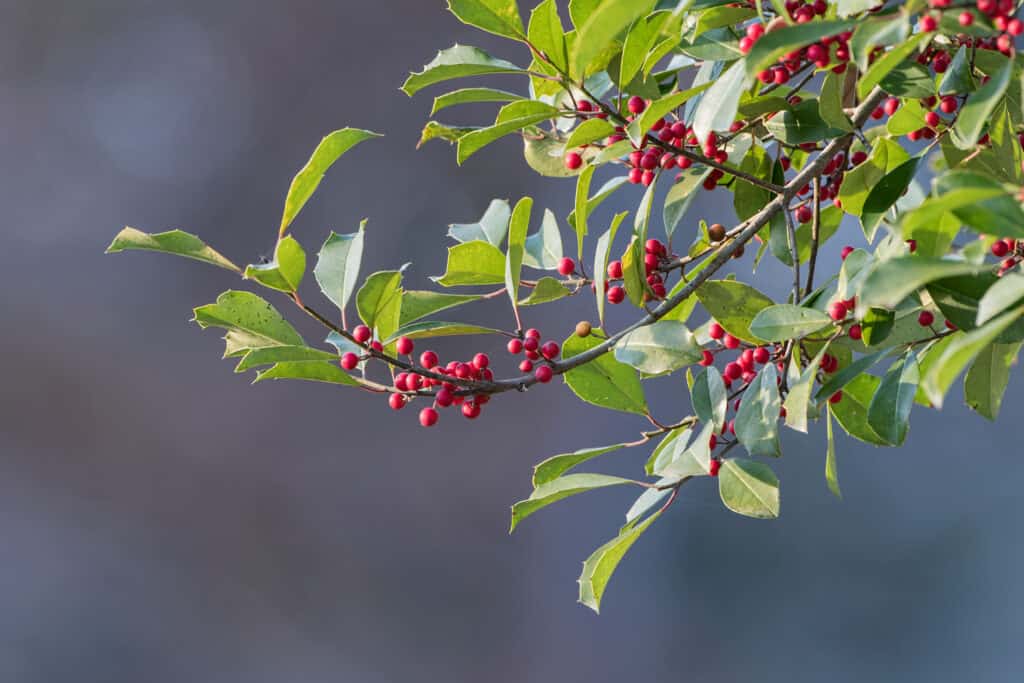
American holly trees are dioecious, meaning they have separate male and female trees. Only female trees produce the iconic red berries.
©Bonnie Taylor Barry/Shutterstock.com
3. American Sycamore (Platanus occidentalis)
Grand and distinctive, the American sycamore is a native tree species that holds a prominent place in the landscapes of Delaware. Renowned for its massive size, unique bark, and adaptability, the American sycamore is an iconic tree in the eastern United States.
People often recognize American sycamores by their towering height, which can reach up to 100 feet or more. The most notable feature of these trees is their striking bark, which peels away in patches to reveal a mottled pattern of white, green, and brown, creating a captivating and distinctive appearance.
The American sycamore’s leaves are equally impressive, with broad, palmate lobes that can span up to 10 inches across. Their large size makes them particularly eye-catching during the growing season. American sycamores are well-suited to riparian habitats and are often found along riverbanks, streams, and other water bodies.
The American sycamore also plays a significant role in stabilizing riverbanks and preventing erosion due to its extensive root system. Moreover, its large canopy provides ample shade, making it a favorite tree for picnics and relaxation along riverfronts. The tree’s small, spherical seed balls, which dangle from its branches, serve as a source of food for various wildlife species, including birds and small mammals.
In addition to its ecological importance, the American sycamore has historical and cultural significance. Native American tribes have used the tree’s bark for various purposes, and early European settlers in the region utilized it for making canoes.
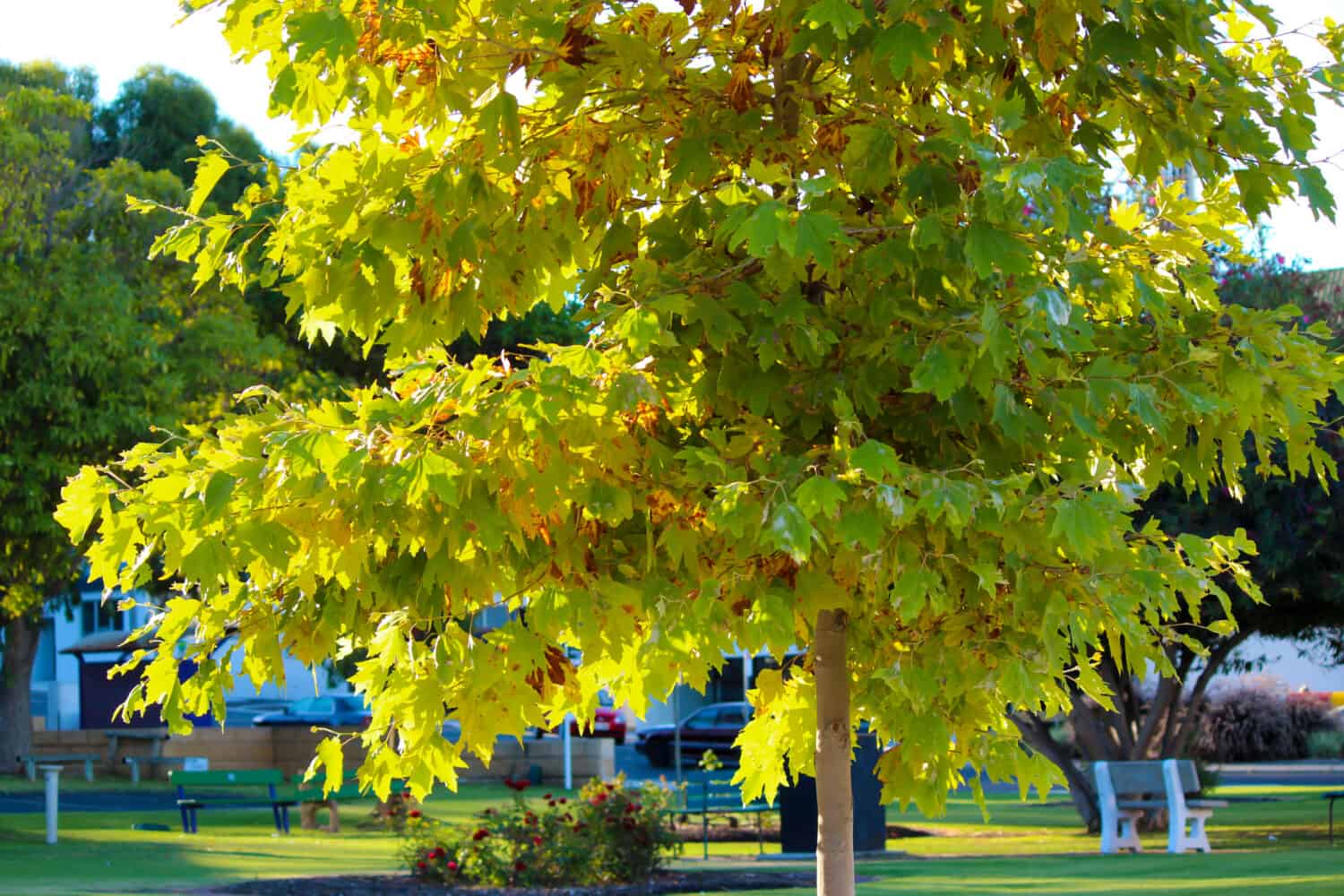
The American sycamore’s unique bark peels away in patches, which not only gives it a striking appearance but also helps to keep the tree’s trunk cool during hot summer months.
©alybaba/Shutterstock.com
4. American Sweet Crabapple (Malus coronaria)
The American sweet crabapple, a native tree to the eastern United States, is a captivating and cherished species known for its ornamental beauty and small, sweet fruit. This tree holds a special place in American landscapes, offering not only aesthetic appeal but also ecological significance.
The American sweet crabapple is a deciduous tree that typically reaches up to 25 feet. Its branches form an attractive, rounded crown adorned with elegant, fragrant white to pale pink blossoms in the spring. These blossoms provide a stunning visual display and a source of nectar for pollinators, including bees and butterflies.
One of the most endearing features of the American sweet crabapple is its small, sweet fruit. These crabapples are not only delectable for humans but also serve as a vital food source for various wildlife species, including birds, deer, and small mammals. The tree’s fruit production contributes to the local ecosystem’s biodiversity. In the autumn, the American sweet crabapple tree transforms, with its deep green leaves transitioning into vibrant shades of yellow and red. This colorful display adds a touch of elegance to the landscape and makes it a popular choice for ornamental purposes.
Throughout history, the American sweet crabapple has held cultural significance. Native American tribes used its fruit for food and traditional medicines, and early European settlers utilized the fruit for jams and jellies. Today, it remains a symbol of Delaware’s local heritage.
It thrives in well-drained soil and prefers full sun to light shade. Furthermore, regular pruning can help maintain the tree’s shape and health. Prune in the late winter or early spring before new growth begins. Remove dead or diseased branches and any crossing or crowded growth to encourage a strong, open canopy.
American sweet crabapple trees are generally hardy and less susceptible to common apple diseases than cultivated apple varieties.
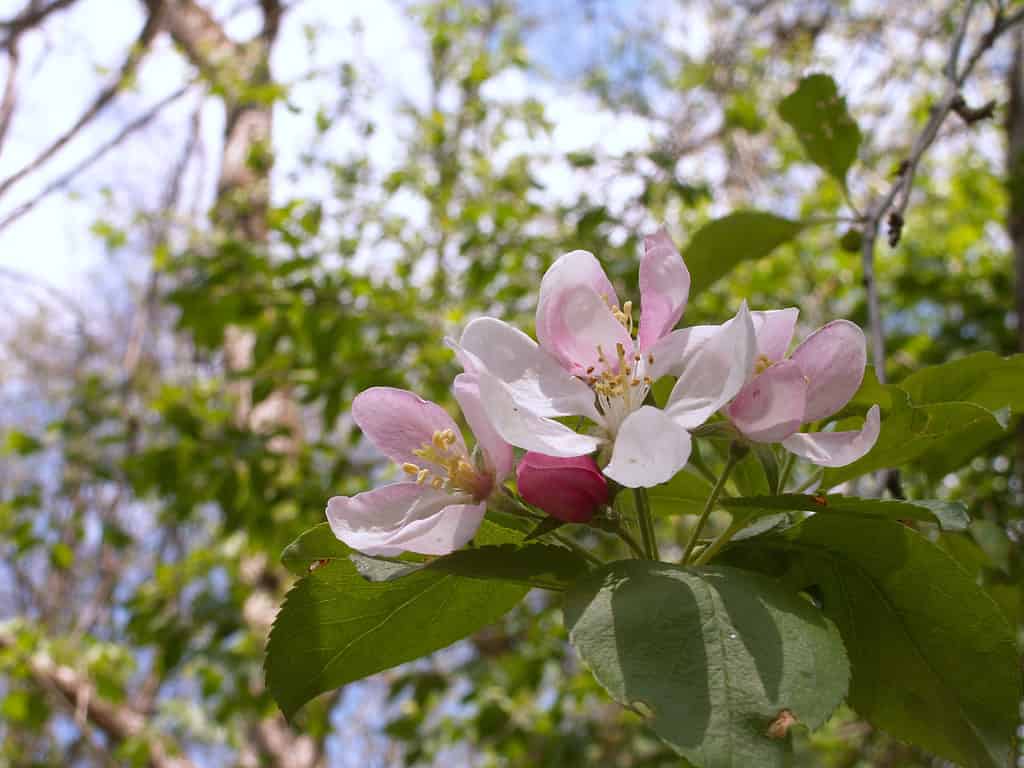
The fruit of the American sweet crabapple is a favorite among wildlife, including birds and deer, making it a valuable food source in the winter.
©Cbaile19, CC0, via Wikimedia Commons – License
5. Black Cherry (Prunus serotina)
The black cherry is a prominent and valuable native tree species found throughout Delaware and the eastern United States. Known for its dark and lustrous bark, delicious fruit, and use in various industries, the black cherry tree holds a special place in both natural landscapes and human endeavors.
Black cherry trees feature tall, straight trunks and smooth, dark bark that matures to a deep, nearly black color. Their leaves are simple, serrated, and dark green with a rich glossy sheen. In the spring, they produce fragrant clusters of white flowers that attract pollinators.
The black cherry tree also produces small, sweet cherries that turn from red to dark purple-black when ripe. These cherries are not only a tasty treat for humans but also a vital food source for a variety of wildlife, including birds like the American Robin and various mammals.
Furthermore, manufacturers prize black cherry wood for its fine grain and reddish-brown color. It is commonly used in the production of fine furniture, cabinets, and flooring. The timber is also valuable for its use in the crafting of musical instruments, particularly pianos and violins. Black cherry trees are adaptable and can be found in a range of habitats, from woodlands to disturbed areas.

Craftsmen have employed black cherry wood in the creation of some of the world’s most renowned musical instruments, such as violins.
©iStock.com/TeleMakro Fotografie (Ina Hensel)
6. Downy Serviceberry (Amelanchier arborea)
Also known as the common serviceberry or shadbush, the downy serviceberry is a graceful and versatile native tree or large shrub found in Delaware. Known for its delicate white blossoms, edible berries, and ecological importance, the downy serviceberry is a cherished component of natural landscapes.
Downy serviceberries are small to medium-sized trees or shrubs that typically reach heights of 15 to 25 feet. They produce graceful, open branches and oval-shaped leaves. During the spring, they burst into bloom with clusters of fragrant white flowers, adding a touch of elegance to the landscape.
One of the most notable features of the downy serviceberry is its sweet and edible fruit. The berries resemble blueberries in appearance and taste, often ripening in the early summer. Humans and animals enjoy its berries, and they also have culinary applications, such as jams and pies.
Downy serviceberries also play a vital role in supporting local wildlife. Their berries are a valuable food source for numerous bird species, including robins, cedar waxwings, and thrushes. Furthermore, the tree provides habitat and shelter for various insects and small mammals.
Historically, downy serviceberries were a valuable resource for Native American tribes and early European settlers. They were consumed fresh or dried and used for medicinal purposes. The trees are adaptable and can be found in a variety of habitats, including woodlands, meadows, and riparian areas.
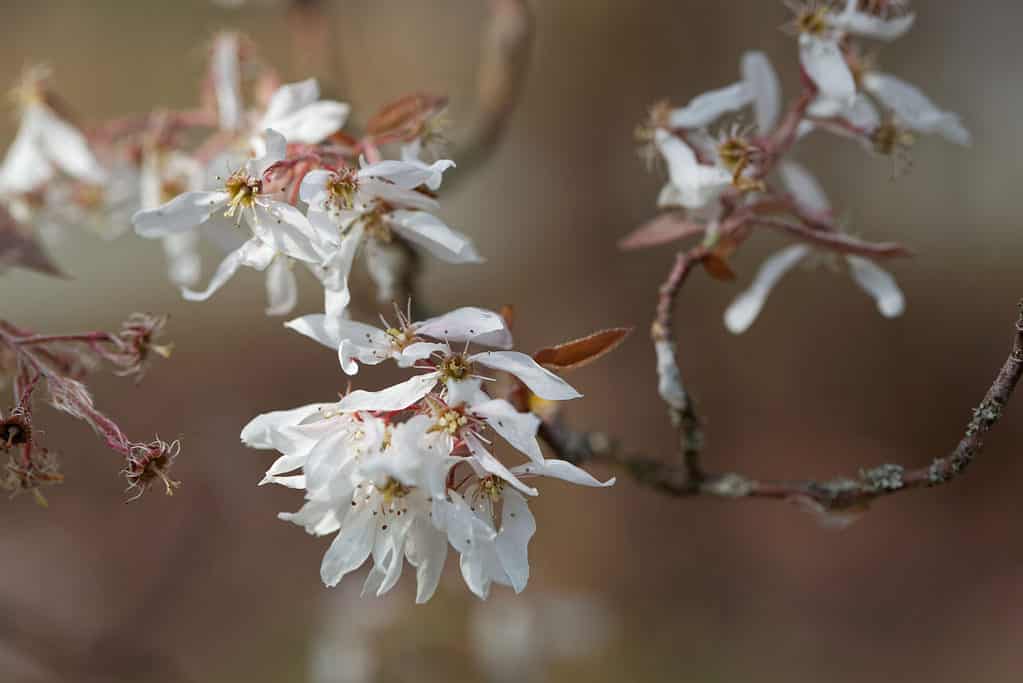
Native American tribes often referred to the fruit of the downy serviceberry as “Juneberries” because they ripen in June and are delicious when fresh.
©iStock.com/weisschr
7. Eastern Redbud (Cercis canadensis)
The Eastern redbud is another charming native tree species that grace many parts of the eastern United States, including Delaware. Known for its captivating early spring blossoms and distinctive heart-shaped leaves, the Eastern Redbud is a beloved addition to both natural landscapes and gardens.
They are small to medium-sized deciduous trees that typically reach up to 30 feet. In the early spring, before the leaves emerge, they produce a profusion of showy pink to lavender-pink blossoms directly on their branches and twigs. These vibrant flowers create a striking contrast against the tree’s gray bark.
The leaves of the eastern redbud are one of its defining features. They are typically heart-shaped with a glossy green surface and a lighter underside. The leaves also provide an attractive canopy throughout the growing season.
Eastern redbuds are versatile and adapt to various environments, including woodlands, meadows, and urban landscapes. Furthermore, the eastern redbud serves as an important source of nectar for pollinators, particularly bees and butterflies, during its spring bloom. Additionally, its small, flat seed pods are consumed by various wildlife species, making it a valuable contributor to local ecosystems.
Locals celebrate the eastern redbud for its early arrival of vibrant blooms, often seen as a herald of spring’s arrival. This tree’s beauty has also led to its use in various art forms and as an ornamental tree in landscaping.
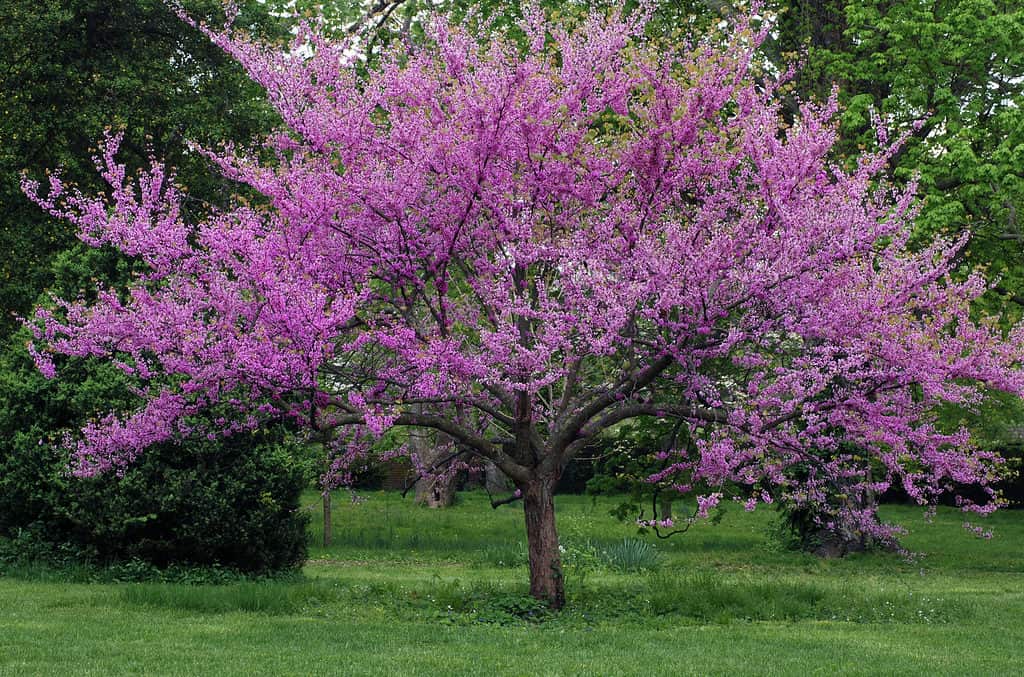
Eastern redbud flowers, in addition to their beauty, are edible and can be utilized in salads or as a garnish in various culinary dishes.
©Marie C Fields/Shutterstock.com
8. Eastern White Pine (Pinus strobus)
Majestic and iconic, the eastern white pine is a coniferous tree native to Delaware. Known for its towering stature, long, soft needles, and historical significance, the eastern white pine is a beloved part of both natural landscapes and American history.
Eastern white pines are large evergreen trees that can reach towering heights of up to 100 feet or more, making them one of the tallest trees in eastern North America. They feature long, slender needles, which grow in clusters of five and can measure between 3 to 5 inches. The tree’s bark is typically grayish and furrowed.
Eastern white pines grow in forests, mountainsides, and riverbanks. They also played a pivotal role in American colonial history, particularly in the early years of European settlements. The colonists valued eastern white pines for their tall, straight trunks, which were used in shipbuilding, including the construction of the famous “Mast Trees,” which became a symbol of colonial defiance during the American Revolution.
Eastern white pines provide habitat and food for various wildlife species. Birds like the pine warbler and red-breasted nuthatch nest in their branches, and their seeds are an important food source for wildlife such as squirrels and certain species of birds. In addition to their ecological importance, easter white pines are also a valuable source of timber for construction, furniture making, and woodworking.
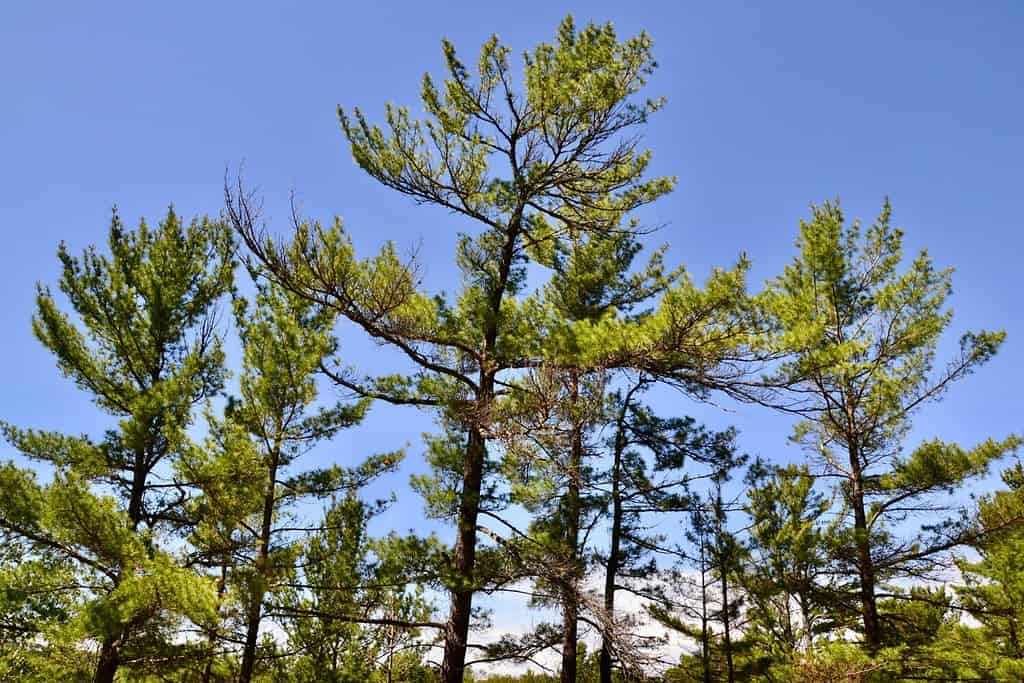
Native American tribes regarded the eastern white pine as the “Tree of Peace” and used it as a symbol of peace and diplomacy among their communities.
©Chris Dale/Shutterstock.com
9. Red Cedar (Juniperus virginiana)
The red cedar is another resilient evergreen tree known for its aromatic wood, small blue-green berries, and adaptability to various environments. It also has cultural, ecological, and practical significance to the Diamond State.
The red cedar is a medium-sized tree that can reach heights of 30 to 50 feet. It produces reddish-brown bark that peels away in strips, giving it a distinctive appearance. The tree’s leaves are scale-like and overlapping, while its small blue-green berries are a notable feature during the fall and winter months.
Red cedars thrive in a wide range of habitats, including dry uplands, forests, and coastal areas. Native American tribes have used various parts of the tree for both practical and ceremonial purposes. The wood was used for crafting tools, shelter, and canoes, while the berries were used for food and medicine.
Furthermore, red cedar trees provide valuable habitat and food for wildlife. Birds, such as cedar waxwings and robins, feed on the berries, while the dense foliage offers shelter and nesting sites for various bird species. The tree’s aromatic wood is also resistant to decay, making it a favored nesting location for cavity-nesting birds.
Manufacturers prize Its wood for its natural resistance to decay and insect infestations and commonly use it for the production of cedar chests, closets, and other storage items to protect clothing and linens from moths and pests. Additionally, the aromatic qualities of the wood make it a popular choice for cedarwood essential oils and sachets.
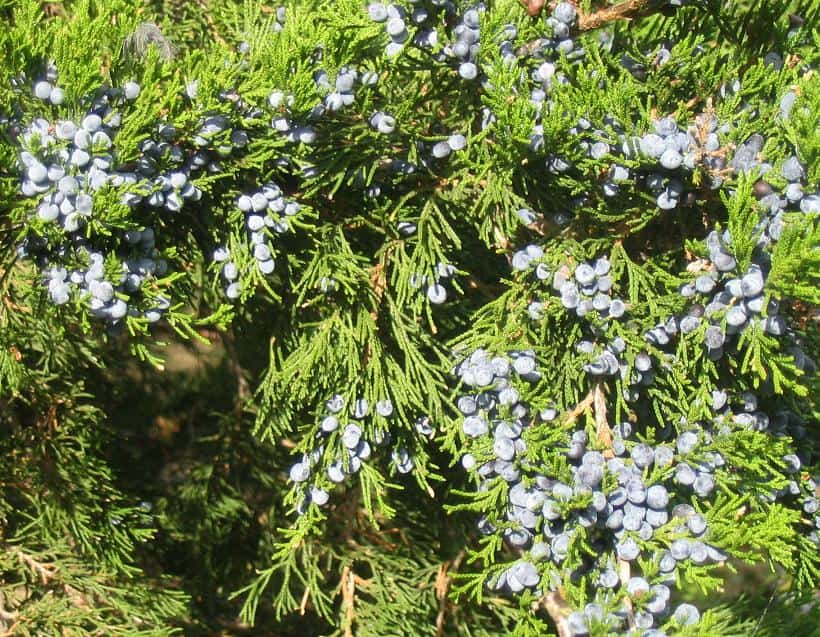
Red cedar wood contains natural oils that give it a pleasant aroma and help protect it from decay, making it ideal for cedar chests and closets.
©Quadell, CC BY-SA 3.0 – License
10. Red Maple (Acer rubrum)
The red maple is a native deciduous tree that is widely distributed throughout North America, including Delaware. Known for its vibrant red foliage in the fall, distinctive red flowers in the spring, and adaptability to various environments, the red maple is a beloved and ecologically important tree species.
Red maples are medium to large-sized trees that typically reach heights of 40 to 70 feet, although some individuals can grow even taller. The tree’s leaves are simple, palmately lobed, and typically have serrated edges. In the spring, before the leaves emerge, red maples produce small clusters of red flowers that add a splash of color to the landscape. In the fall, the leaves turn brilliant shades of red, orange, or yellow, making them one of the most striking trees in Delaware’s woodlands.
Red maples grow throughout Delaware’s wetlands, swamps, floodplains, and upland forests. They provide essential habitat and food for wildlife. Birds such as woodpeckers, songbirds, and waterfowl also use the trees for nesting, and their seeds are consumed by squirrels and other small mammals. Additionally, the tree’s nectar-rich flowers attract pollinators, including bees and butterflies.
Red maples have cultural and economic importance in Delaware and the broader region. Manufacturers use their wood for various products, including furniture, flooring, and musical instruments. Residents and visitors also celebrate and appreciate the tree’s vibrant fall colors.
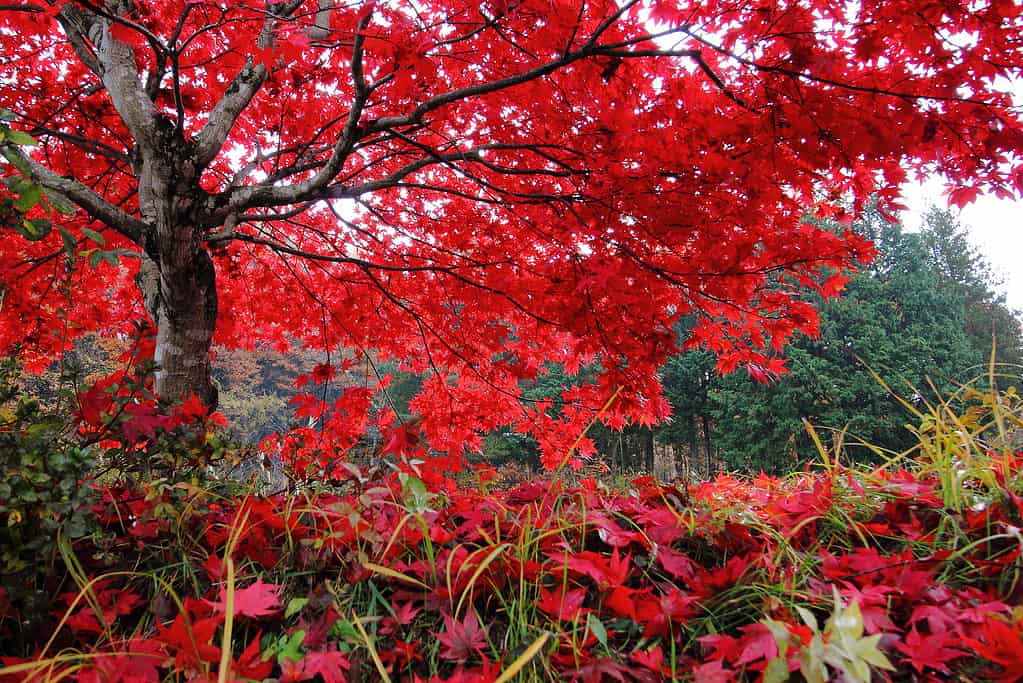
Red maple trees earned the nickname “swamp maples” because they are commonly found in wetland areas and thrive in soils with high moisture content.
©KungChuyada/Shutterstock.com
11. Sweetgum (Liquidambar styraciflua)
The sweetgum tree is another native deciduous tree that produces star-shaped leaves, spiky fruits, and unique autumn foliage. They are medium to large-sized trees that can reach heights of 60 to 100 feet or more. Their leaves are deeply lobed and star-shaped, making them easily recognizable. During the fall, the leaves turn a striking mix of red, orange, and purple, creating a vibrant display of autumn colors.
One of the most distinctive features of sweetgum trees is their spiky, spherical fruits, often referred to as “gumballs” or “burr balls.” These fruits contain small seeds and can persist on the tree throughout the winter.
Specimens grow throughout wetlands, bottomlands, and upland forests. Additionally, they provide habitat and food for wildlife. Birds and small mammals consume the seeds from the tree’s fruits. Furthermore, the tree’s dense canopy offers shelter for various bird species.
Historically, Native American tribes and early European settlers used the resin from sweetgum trees for medicinal purposes. Today, manufacturers use the wood of sweetgum trees for furniture, veneer, and other woodworking applications.

People often refer to the spiky fruits of the sweetgum tree as “gumballs” and sometimes incorporate them into crafts and decorations.
©iStock.com/sundry photography
12. Tulip Poplar (Liriodendron tulipifera)
Also known as the yellow poplar, the tulip poplar is a prominent and distinctive native tree species found in Delaware. Known for its tall stature, unique leaf shape, and vibrant tulip-like flowers, the tulip poplar is a beloved and ecologically important tree.
Specimens feature tall, straight trunks that can reach heights of 70 to 90 feet or more. Their leaves are large, with a distinctive shape resembling a tulip, featuring four lobes and a flat top. In the spring and early summer, these trees produce striking yellow-green, tulip-like flowers, which give the tree its name.
Tulip poplars grow in a variety of habitats in the First State, including forests, floodplains, and upland areas. They provide essential habitat and food for wildlife. Birds, such as the yellow-bellied sapsucker, Eastern bluebird, and ruby-throated hummingbird, visit these trees for insects and nectar. Additionally, the tree’s seeds are a food source for various animals, including squirrels and deer.
Furthermore, native American tribes and early European settlers used various parts of the tree for construction, medicine, and crafting. The tree’s towering presence and unique flowers make it a symbol of natural beauty. Its wood is also lightweight, straight-grained, and easy to work with, making it valuable for various woodworking applications, including furniture, cabinetry, and musical instruments.
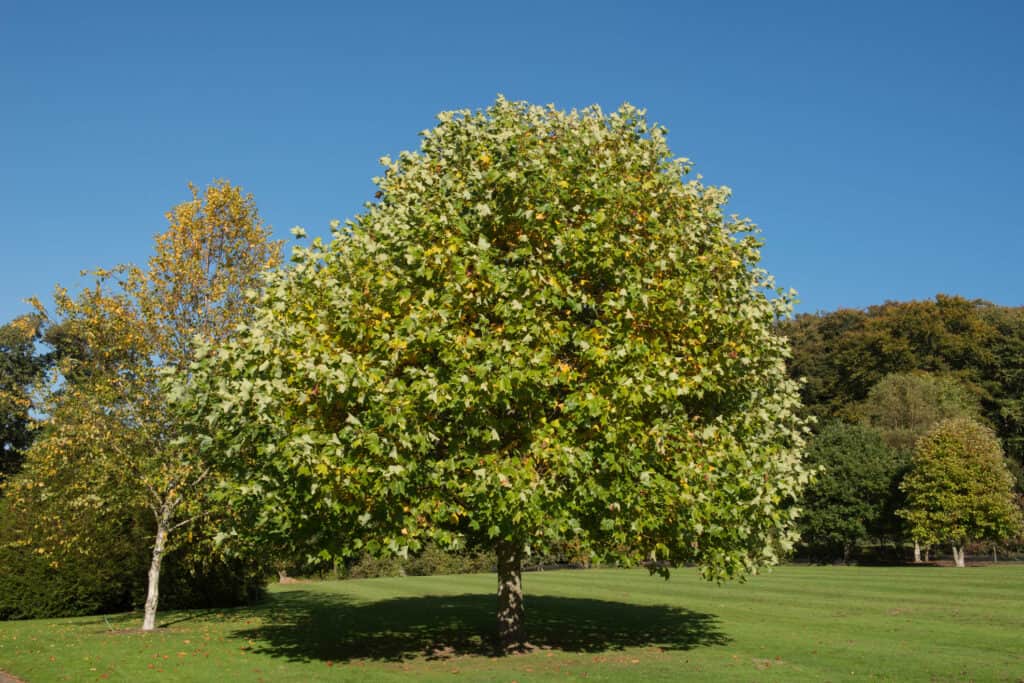
The tulip poplar is not actually a true poplar but is part of the magnolia family. It gets its name from its tulip-like flowers.
©iStock.com/pcturner71
13. White Ash (Fraxinus americana)
White Ash is a majestic native tree that holds a special place in Delaware’s landscape. With its striking appearance and valuable wood, this tree has earned its status as one of Delaware’s most iconic tree species. White ash produces a tall, straight trunk and dense, broad crown. Furthermore, its bark is light gray and smooth when young, developing distinct diamond-shaped ridges as it matures.
The leaves of the white ash are pinnately compound, usually consisting of five to nine leaflets, which turn a vibrant golden-yellow in the fall, creating a breathtaking display of autumn color. Find specimens growing throughout Delaware, thriving in a variety of habitats, including woodlands, floodplains, and even urban areas.
This adaptable tree is also native to a large portion of North America, from eastern Canada down to northern Florida and west to the Great Plains. The white ash plays a crucial role in Delaware’s ecosystems. Its seeds are a valuable food source for a variety of wildlife, including birds, squirrels, and deer. Additionally, the tree’s dense canopy provides shade and shelter for countless other plant and animal species.
White ash wood is strong and flexible with a straight grain and is commonly used in the manufacturing of furniture, tool handles, sports equipment (such as baseball bats), and even musical instruments. However, the tree’s economic significance extends beyond the woodworking industry, as it also contributes to the state’s tourism and recreational sectors.
The white ash thrives in full sun to partial shade but prefers at least six hours of sun per day. Specimens adapt to a range of soil types and are sturdy against high winds.
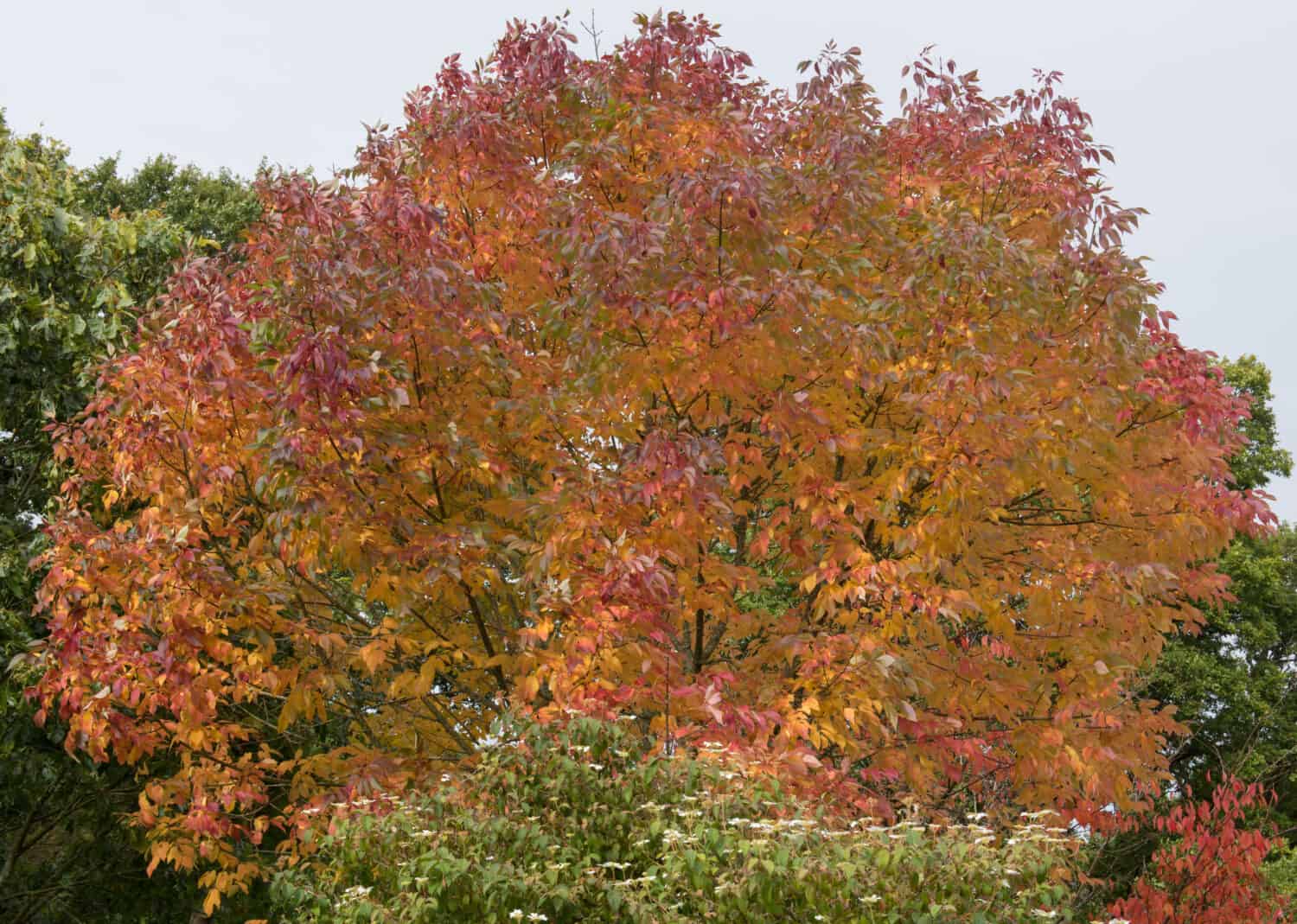
White ash wood’s strength and flexibility make it a preferred choice for crafting baseball bats.
©Peter Turner Photography/Shutterstock.com
14. White Oak (Quercus alba)
The white oak is a stately and iconic native tree species found throughout Delaware and much of North America. Known for its strong and durable wood, lobed leaves with rounded tips, and acorn-bearing capabilities, the white oak holds significant cultural, ecological, and economic importance.
White oak trees reach impressive heights up to 100 feet or more. Their leaves are simple, with rounded lobes and rounded tips. In the fall, the leaves turn various shades of red, brown, and purple.
White oaks thrive in a range of habitats, including forests, woodlands, and upland areas. Manufacturers value their wood for its strength, durability, and attractive grain and commonly use it in the construction of furniture, flooring, barrels for aging spirits like whiskey, and various other woodworking applications. The wood’s resistance to decay also makes it particularly valuable.
White oak trees provide essential habitat and food for wildlife. Their acorns are an important food source for a wide range of animals, including deer, squirrels, and various bird species. They also have cultural and historical significance in Delaware. Native American tribes and early European settlers used different parts of the tree for tools, shelter, and crafting. Furthermore, the white oak has also been a symbol of strength and longevity in American culture.
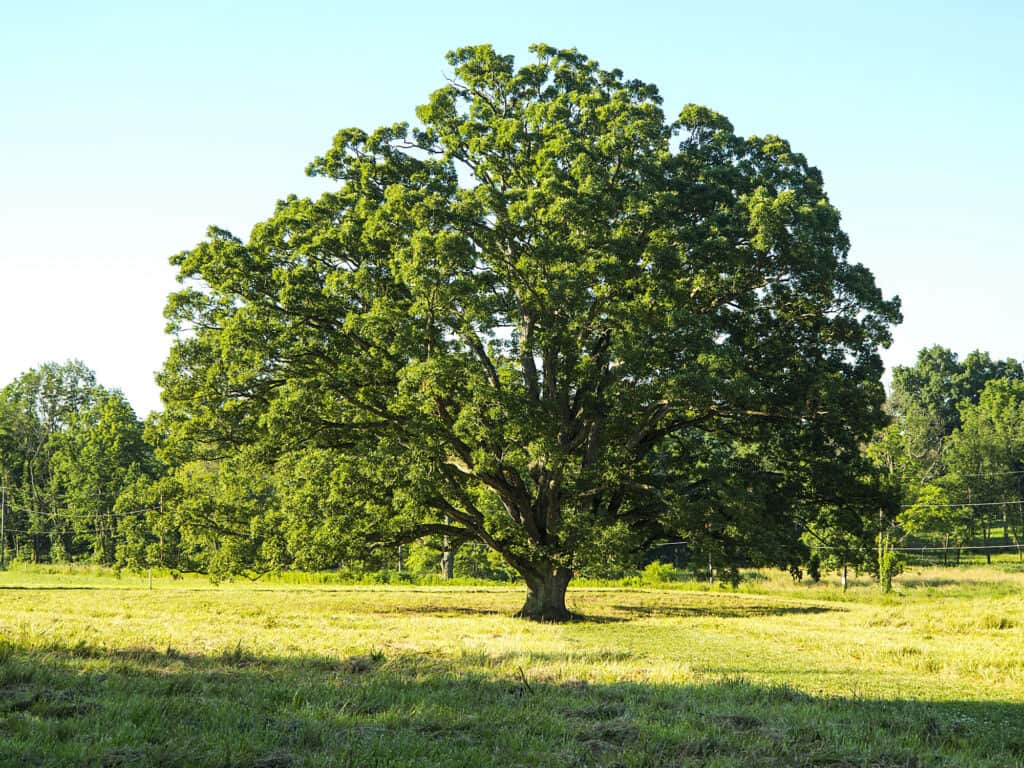
The USS Constitution, the world’s oldest commissioned warship afloat, primarily consists of white oak in its construction.
©iStock.com/Cris Andrei
15. Witch Hazel (Hamamelis virginiana)
Witch hazel is a unique small tree found in various parts of the United States, including Delaware. Known for its distinctive spidery yellow flowers, interesting seed capsules, and medicinal uses, witch hazel is a notable and versatile plant.
It typically grows to a height of 10 to 15 feet, and its leaves are oval-shaped with wavy edges. They turn vibrant shades of yellow and orange in the fall. One of the most distinctive features of witch hazel is its late-blooming, spidery yellow flowers, which appear in the fall when most other plants have finished flowering.
Witch hazel grows in woodland understories and along stream banks in Delaware and throughout the eastern United States. It has a long history of medicinal use. Its bark, leaves, and twigs contain tannins, which have astringent properties. Witch hazel extracts are commonly used topically for their soothing and anti-inflammatory effects, making them popular for treating skin irritations, such as insect bites, rashes, and minor cuts.
Witch hazel also provides important food for various wildlife species. The seeds within its unique, exploding capsules are a valuable winter food source for birds, especially grouse and turkeys. Furthermore, witch hazel has been used in traditional medicine by Native American tribes and early European settlers. Today, it is a common ingredient in a wide range of skincare and cosmetic products.
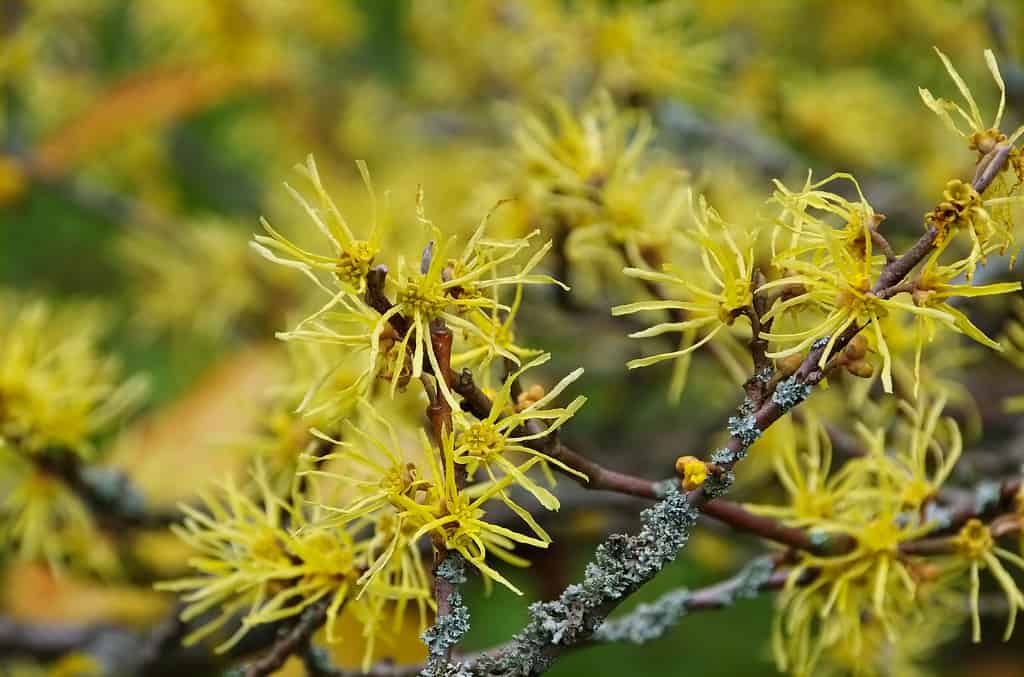
Many people consider witch hazel extracts a staple in their medicine cabinets due to their soothing properties, using them in various skincare products and as an astringent.
©LianeM/iStock via Getty Images
Summary: 15 Most Iconic Trees Native to Delaware
| Number | Common Name | Sunlight Requirements |
|---|---|---|
| 1 | American Beech | Partial to Full Shade |
| 2 | American Holly | Full Sun to Partial Shade |
| 3 | American Sycamore | Full Sun to Partial Shade |
| 4 | American Sweet Crabapple | Full Sun to Partial Shade |
| 5 | Black Cherry | Full Sun to Partial Shade |
| 6 | Downy Serviceberry | Full Sun to Partial Shade |
| 7 | Eastern Redbud | Full Sun to Partial Shade |
| 8 | Eastern White Pine | Full Sun to Partial Shade |
| 9 | Red Cedar | Full Sun |
| 10 | Red Maple | Full Sun to Partial Shade |
| 11 | Sweetgum | Full Sun to Partial Shade |
| 12 | Tulip Poplar | Full Sun to Partial Shade |
| 13 | White Ash | Full Sun to Partial Shade |
| 14 | White Oak | Full Sun to Partial Shade |
| 15 | Witch Hazel | Full Sun to Partial Shade |
The photo featured at the top of this post is © ForestSeasons/Shutterstock.com
Thank you for reading! Have some feedback for us? Contact the AZ Animals editorial team.






